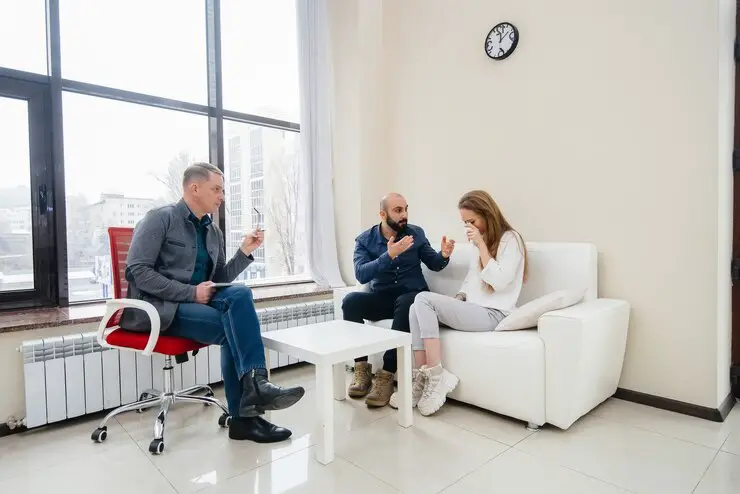7 Effective Therapeutic Approaches and Guide on Navigating Verbal Abuse in Couples Therapy

Couples therapy can be a powerful tool for fostering communication, resolving conflicts, and strengthening relationships. However, when one partner exhibits verbally abusive behavior, it adds complexity and requires a specialized approach. Verbal abuse can manifest in various forms, including insults, criticism, belittling, and manipulation, and it can have detrimental effects on both partners’ well-being and the overall health of the relationship. In this article, we explore the best therapeutic approaches for addressing verbal abuse within the context of couples therapy.

Page Contents
- 1 7 Effective Therapeutic Approaches and Guide on Navigating Verbal Abuse in Couples Therap
- 2 6th: Assertiveness Training
- 3 7th: Conflict Resolution Strategies
- 4 Let’s delve deeper into the examples of Cognitive-Behavioral Therapy (CBT) and Emotionally Focused Therapy (EFT) approaches within couples therapy:
- 5 A> Cognitive-Behavioral Therapy (CBT)
- 6 B> Emotionally Focused Therapy (EFT)
- 7 C> 10 Conflict Resolution Strategies
- 8 Here are some conflict resolution strategies that can be employed within couples therapy:
- 9 Conclusion
1st: Understanding Verbal Abuse
Before delving into therapeutic strategies, it’s crucial to understand the dynamics of verbal abuse. Verbal abuse is not merely about occasional disagreements or heated arguments; it involves a pattern of behavior aimed at controlling, demeaning, or intimidating the other person. It can erode self-esteem, foster feelings of worthlessness, and create a toxic environment within the relationship. Recognizing the signs of verbal abuse is the first step toward addressing it in therapy.
2nd: Creating a Safe Environment
In couples therapy, creating a safe and supportive environment is paramount, particularly when dealing with issues of verbal abuse. The therapist plays a crucial role in establishing ground rules for communication and ensuring that both partners feel heard and respected. This may involve setting boundaries around language and behavior, emphasizing active listening skills, and promoting empathy and understanding.
3rd: Individual and Couples Counseling
Addressing verbal abuse often requires a multifaceted approach that combines individual and couples counseling. The verbally abusive partner may benefit from individual therapy to explore the underlying causes of their behavior, such as unresolved trauma, insecurity, or communication deficits. In couples counseling, both partners can work together to identify triggers, improve communication patterns, and develop healthy coping mechanisms.
4th: Cognitive-Behavioral Therapy (CBT)
Cognitive-behavioral therapy (CBT) is an evidence-based approach that can be effective in treating verbal abuse within the context of couples therapy. CBT focuses on identifying and challenging negative thought patterns and beliefs that contribute to abusive behavior. Through CBT techniques, such as cognitive restructuring and behavioral rehearsal, couples can learn to replace destructive communication patterns with more constructive alternatives.
5th: Emotionally Focused Therapy (EFT)
Emotionally focused therapy (EFT) is another valuable therapeutic approach for addressing verbal abuse in couples therapy. EFT helps couples identify and express their underlying emotions and attachment needs, fostering greater intimacy and connection. By exploring the emotional dynamics that underlie verbal abuse, couples can cultivate empathy, rebuild trust, and strengthen their bond.
6th: Assertiveness Training
Many verbally abusive individuals lack healthy assertiveness skills, leading them to resort to aggression or manipulation to communicate their needs. In couples therapy, assertiveness training can help both partners learn to express themselves openly and respectfully. By teaching assertiveness techniques, such as “I” statements and active listening, couples can communicate more effectively and reduce the likelihood of verbal abuse.
7th: Conflict Resolution Strategies
Effective conflict resolution is essential for managing verbal abuse in couples therapy. Therapists can teach couples specific strategies for de-escalating conflicts, such as taking breaks when emotions run high, using “time-out” techniques, and practicing reflective listening. By learning constructive ways to address disagreements, couples can prevent verbal abuse from escalating and find mutually satisfactory resolutions.


Let’s delve deeper into the examples of Cognitive-Behavioral Therapy (CBT) and Emotionally Focused Therapy (EFT) approaches within couples therapy:
A> Cognitive-Behavioral Therapy (CBT)
In the context of couples therapy, CBT can be applied to address the verbally abusive husband’s negative thought patterns and beliefs that contribute to his behavior. Here’s a more detailed example:
Example: The therapist starts by helping the verbally abusive husband identify specific situations or triggers that lead to his abusive behaviors, such as feeling criticized or insecure. Through collaborative exploration, the therapist assists him in recognizing automatic thoughts associated with these triggers, such as “She’s trying to undermine me” or “I have to put her down to assert control.”
Once these thoughts are identified, the therapist works with the husband to evaluate their accuracy and validity. Together, they examine evidence for and against these thoughts, considering alternative explanations for his partner’s behaviors. For instance, they might explore times when his partner’s actions were not intended to criticize or challenge him.
Next, the therapist guides the husband in generating more balanced and constructive interpretations of his partner’s behavior. They may develop coping statements or affirmations to challenge negative thoughts in the moment, such as “My partner loves me and wants what’s best for us” or “I can express my feelings without resorting to insults.”
Throughout the therapy process, the husband practices implementing these cognitive restructuring techniques both in session and in real-life situations with his partner. Over time, he becomes more adept at recognizing and challenging his negative thought patterns, leading to reduced instances of verbal abuse and improved communication within the relationship.
B> Emotionally Focused Therapy (EFT)
EFT focuses on identifying and addressing underlying emotions and attachment needs within the relationship. Here’s how it might be applied to the scenario of a verbally abusive husband and his partner:
Example: In EFT sessions, the therapist creates a safe and supportive environment for the couple to explore their emotional experiences and attachment dynamics. They begin by helping the verbally abusive husband and his partner identify primary emotions underlying their conflicts, such as fear, sadness, or shame.
Through guided conversations and experiential exercises, the therapist facilitates deeper emotional expression and empathy between the partners. The husband may come to understand that his abusive behaviors stem from a fear of vulnerability or a need for emotional closeness, rather than a desire to control or dominate.
As the couple progresses through EFT, they work together to reshape their patterns of interaction and communication. The therapist helps them recognize moments of emotional disconnection or distress and develop strategies for effectively expressing their needs and desires.
Through this process, the verbally abusive husband learns to communicate his emotions and attachment needs more openly and directly, reducing the reliance on abusive behaviors as a means of asserting control. The couple cultivates a deeper understanding of each other’s emotional worlds and strengthens their bond, leading to greater intimacy and mutual support in the relationship.
In summary, both CBT and EFT offer valuable frameworks for addressing verbal abuse within couples therapy, helping the partners understand the underlying drivers of abusive behaviors and develop healthier patterns of communication and interaction.
C> 10 Conflict Resolution Strategies
Here are some conflict resolution strategies that can be employed within couples therapy:
- Active Listening: Encourage both partners to actively listen to each other’s perspectives without interrupting or formulating a response. This promotes understanding and validation of each other’s feelings.
- Use “I” Statements: Encourage the use of “I” statements to express feelings and needs without blaming or accusing the other person. For example, “I feel hurt when you raise your voice at me” instead of “You always yell at me.”
- Take Breaks: Agree on a signal or phrase to indicate when a conversation is becoming too heated, and take a break to cool down before continuing the discussion. This prevents escalation and allows emotions to settle.
- Time-Out Technique: Implement a time-out strategy where either partner can call for a pause in the conversation if it becomes too intense or unproductive. During the time-out, both partners should take a break to calm down before returning to the discussion.
- Reflective Listening: Practice reflective listening by paraphrasing and summarizing the other person’s statements to ensure understanding. This demonstrates empathy and validates the other person’s feelings.
- Seek Compromise: Encourage both partners to identify common goals and interests and work together to find mutually acceptable solutions. This fosters collaboration and promotes a sense of partnership.
- Focus on the Present: Encourage both partners to focus on the current issue at hand rather than bringing up past grievances or unrelated issues. This keeps the conversation focused and productive.
- Express Appreciation: Encourage the expression of appreciation and gratitude for each other’s efforts and positive qualities, even during disagreements. This helps maintain a sense of connection and goodwill.
- Set Boundaries: Establish clear boundaries around acceptable behavior and communication, and hold each other accountable for respecting these boundaries. This promotes mutual respect and creates a sense of safety within the relationship.
- Seek Professional Mediation: In cases where conflicts persist or become particularly challenging to resolve, consider seeking professional mediation or counseling to facilitate constructive dialogue and problem-solving.
By implementing these conflict resolution strategies, couples can navigate disagreements more effectively, reduce tension and hostility, and foster greater harmony and understanding within the relationship.
Conclusion
Verbal abuse poses significant challenges in couples therapy, but with the right therapeutic approach, couples can overcome its destructive effects and rebuild a healthier relationship. By creating a safe environment, combining individual and couples counseling, utilizing evidence-based techniques such as CBT and EFT, and focusing on assertiveness and conflict resolution, therapists can help couples break free from the cycle of verbal abuse and cultivate a more loving and respectful partnership.







